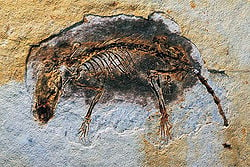Difference between revisions of "Placentalia" - New World Encyclopedia
Rick Swarts (talk | contribs) |
Rick Swarts (talk | contribs) |
||
| Line 9: | Line 9: | ||
| phylum = [[Chordate|Chordata]] | | phylum = [[Chordate|Chordata]] | ||
| classis = [[Mammal]]ia | | classis = [[Mammal]]ia | ||
| − | | | + | | cladis = '''Eutheria''' |
| infraclassis = '''Placentalia''' (placental mammals) | | infraclassis = '''Placentalia''' (placental mammals) | ||
| subdivision_ranks = Subgroups | | subdivision_ranks = Subgroups | ||
Revision as of 22:32, 30 April 2014
| Eutherians
| ||||||||
|---|---|---|---|---|---|---|---|---|
 Fossil specimen of Eomaia scansoria, an early eutherian
| ||||||||
| Scientific classification | ||||||||
| ||||||||
|
Placentalia is a group of mammals. The majority of living mammals are placental: the other two living mammal groups are the Monotremata and the Marsupialia. The placentals are distinguished from other mammals in that the fetus is nourished during gestation via a placenta while, in general, this is not the case with other mammals (Bandicoots are an exception). They reproduce sexually, and the young is carried in the mother until fully developed. Placental mammals are viviparous.
Evolution
The earliest known placental mammal species (including Protungulatum donnae, Purgatorius coracis, and Leptacodon proserpinae) are all dated to the early Paleogene period, about 65 million years ago. True placental mammals appeared shortly after the K-Pg extinction event and quickly diversified into ecological niches previously occupied by various groups of dinosaurs and other prehistoric reptiles.[1] True placental mammals (the crown group of all modern placentals) arose from stem-group members of the clade Eutheria, which had existed since at least the mid-Jurassic period.[2]
Description
Placental mammals are distinguished from other eutherians by:
- the presence of a malleolus at the bottom of the fibula, the smaller of the two shin bones.[2]
- a complete mortise and tenon upper ankle joint, where the rearmost bones of the foot fit into a socket formed by the ends of the tibia and fibula.[2]
- a wide opening at the bottom of the pelvis, which allows the birth of large, well-developed offspring. Marsupials and nonplacental eutherians have a narrower opening that allows only small, immature offspring to pass through.[3]
- the absence of epipubic bones extending forward from the pelvis, which are not found in any placental, but are found in all other mammals – nonplacental eutherians, marsupials, monotremes, and earlier mammaliaforms - as well as in other cynodonts that are closest to mammals. Their function is to stiffen the body during locomotion.[4] This stiffening would be harmful in pregnant placentals, whose abdomens need to expand.[5]
Classification
Placentals are divided into three major groups:[6]
- Boreoeutheria, e.g. badgers, rabbits, guinea pigs, dogs
- Xenarthra, e.g. armadillos, anteaters
- Afrotheria, e.g. elephants, hyraxes, manatees
Molecular studies based on DNA analysis have revised the understanding of relationships among placental groups during the 21st century.[7] Classification systems based on molecular studies reveal three major groups or lineages of placental mammals: Afrotheria, Xenarthra, and Boreoeutheria, all of which diverged from common ancestors in the Cretaceous. The exact relationships between these three lineages is currently a subject of debate, and three different hypotheses have been proposed with respect to which group is basal, or diverged first from other placentals. These hypotheses are Atlantogenata (basal Boreoeutheria), Epitheria (basal Xenarthra), and Exafroplacentalia (basal Afrotheria).[8] Boreoeutheria in turn contains two major lineages- Euarchontoglires and Laurasiatheria.
Estimates for the divergence times among these three placental groups range from 105 to 120 million years ago, depending on type of DNA (e.g. nuclear or mitochondrial)[9] and varying interpretations of paleogeographic data.[8]
ReferencesISBN links support NWE through referral fees
- ↑ (8 February 2013)The Placental Mammal Ancestor and the Post–K-Pg Radiation of Placentals. Science 339 (6120): 662–667.
- ↑ 2.0 2.1 2.2 Ji, Q., Luo, Z-X., Yuan, C-X.,Wible, J.R., Zhang, J-P. and Georgi, J.A. (April 2002). The earliest known eutherian mammal. Nature 416 (6883): 816–822.
- ↑ Weil, A. (April 2002). Mammalian evolution: Upwards and onwards. Nature 416 (6883): 798–799.
- ↑ Reilly, S.M., and White, T.D. (January 2003). Hypaxial Motor Patterns and the Function of Epipubic Bones in Primitive Mammals. Science 299 (5605): 400–402.
- ↑ Novacek, M.J., Rougier, G.W, Wible, J.R., McKenna, M.C, Dashzeveg, D.,and Horovitz, I. (October 1997). Epipubic bones in eutherian mammals from the Late Cretaceous of Mongolia. Nature 389 (6650): 483–486.
- ↑ Archibald JD, Averianov AO, Ekdale EG (November 2001). Late Cretaceous relatives of rabbits, rodents, and other extant eutherian mammals. Nature 414 (6859): 62–5.
- ↑ Kriegs, Jan Ole and Churakov, Gennady; Kiefmann, Martin; Jordan, Ursula; Brosius, Jürgen; Schmitz, Jürgen (2006). Retroposed Elements as Archives for the Evolutionary History of Placental Mammals. PLoS Biology 4 (4): e91.
- ↑ 8.0 8.1 Nishihara, H. and Maruyama, S.; Okada, N. (2009). Retroposon analysis and recent geological data suggest near-simultaneous divergence of the three superorders of mammals. Proceedings of the National Academy of Sciences 106 (13): 5235–5240.
- ↑ Template:Cite doi
Credits
New World Encyclopedia writers and editors rewrote and completed the Wikipedia article in accordance with New World Encyclopedia standards. This article abides by terms of the Creative Commons CC-by-sa 3.0 License (CC-by-sa), which may be used and disseminated with proper attribution. Credit is due under the terms of this license that can reference both the New World Encyclopedia contributors and the selfless volunteer contributors of the Wikimedia Foundation. To cite this article click here for a list of acceptable citing formats.The history of earlier contributions by wikipedians is accessible to researchers here:
The history of this article since it was imported to New World Encyclopedia:
Note: Some restrictions may apply to use of individual images which are separately licensed.

